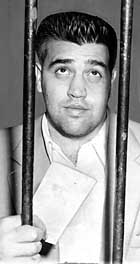Most Americans can't recognize the faces of all of our presidents, but almost everyone can recognize the face of Al "Scareface" Capone. The most popular infamous gangster of his time. Much like a John Gotti, he was flashy, flamboyant and did not care who knew he was a gangster. And this is how most of the Chicago Outfit operated in the Scareface era.

Prohibition: The Start
Most people probably never heard the names Jim Colosimo or Johnny Torrio. Jim Colosimo was the first to bring about the illegal sales of alcohol. Johnny Torrio, new from New York, had asked Jim Colosimo if his crew and he could go into business with him? But Colosimo declined with good reason, he believed that it would bring to much heat onto the operation, he was right.After some more polite offering and more stern declines Johnny decided to take a different approach to his offer. Torrio lured Colosimo into a meeting where he would be surprised by two gunmen and shot dead. Although no one was charged with the killing it was long believed that it was Al Capone and Franky Yale who pulled it off.

Johnny Torrio Stepped up and took the number one spot in the Italian bootlegging industry and turned Capone into his second hand man. But even know the dual seemed unstoppable there was an Irish gang that wanted in on the action as well. This turned into to a lot of years of gangland fighting and shootouts. One gun fight made it to Torrio, leaving him injured and unable to run the gang and with that he passed the thrown on to Capone. Now in his late twenties Capone ran one of the most powerful criminal organization in America, the Chicago outfit.
Capone's 2nd Hand Man
Capone also found a second hand man, Frank "The Enforcer" Nitti. With Nitti's business man mentality and the brutality of someone that people would fear with good reason, Capone knew Nitti was exactly what he needed. When Capone had enough of the Irish gang that they were at war with over turf, the same mob that gave Torrio the shots that ended his career, Capone gave the OK to Nitti to take care of them by any means possibly. This would set-up the infamous Valentine massacre.
Capone first left the outfit in Nitti's hands when he spent a year in a Philadelphia prison on weapon charges and then again when Capone took his finial trip to prison on tax evasion charges. Although he only spent about two years on the tax evasion charges, he returned unable to be a boss due to catching sypilis.
So, Nitti proceeded to be boss but proceeded to have problems with running the outfit. One of his biggest problems was the legalization of alcohol, the outfits main source of income. But Nitti was resourceful and found other ways of bringing in money for the gang. Nitti set his sights on the unions in the movie making industry, which turned out to be very profitable until he stepped on one to many toes.

Eventually, a lot of people wanted Nitti out of the way including the Government. Unfortunately, Nitti's great business skills came back and bit him in the ass, because he saved all of his records the Government was able to bring charges on him and other bosses for racketeering and extortion of unions. Two of Nitti's men informed on the outfit and other gangs and since they were Nitti's men, Nitti was told to take all of the blame himself or he would be taken care of in mob fashion. Nitti did not want to do the jail time especially since it was going to be a life sentence. So one day Nitti got extremely drunk, stumbled out to some railroad tracks and took two shoots with a pistol that missed his head and a third that met it's mark and left him for dead.
The End for The Outfit
The bootlegging powerful Chicago Outfit was diminished to practically nothing. The Chicago mob would come back around and play a huge part in Las Vegas and become a huge player in the underworld again, but not for quite a few years.Even know you probably would not recognized three of the four faces in this post, without these three unfamiliar looking mobsters, Al "Scareface" Capone may of never been the famous mobster that he was.
